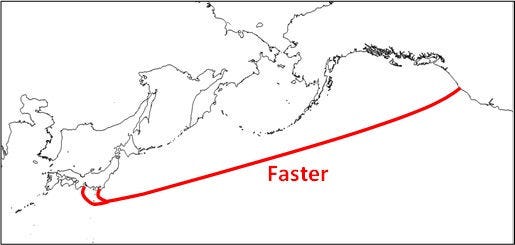China Mobile, KDDI and Google among $300m Pacific cable consortium
A consortium of six companies has agreed to build and operate a new trans-Pacific cable system linking Japan with the US. It has an initial design capacity of 60Tb per second and is consequently called ‘FASTER’, despite not apparently being an acronym.
August 12, 2014

A consortium of six companies has agreed to build and operate a new trans-Pacific cable system linking Japan with the US. It has an initial design capacity of 60Tb per second and is consequently called ‘FASTER’, despite not apparently being an acronym.
There are, of course, plenty of trans-Pacific communications cables already littering the ocean floor, but such is the current growth in demand for data networks that a new one is clearly worth laying. The consortium consists of China Mobile International, China Telecom Global, Global Transit, Google, KDDI and SingTel. The data capacity is achieved by using 6 fiber-pairs, each of which can carry 100 wavelengths of 100Gbps capacity, and the project is expected to set the consortium back around $300 million.
Woohyong Choi, chairman of the FASTER executive committee, said, “The FASTER cable system has the largest design capacity ever built on the trans-Pacific route, which is one of the longest routes in the world. The agreement announced today will benefit all users of the global Internet.”
NEC has been announced as the system supplier. “NEC Corporation is proud to be the system supplier for the FASTER cable system, a state-of-the-art long haul system that will provide additional connectivity and capacity between regions of the world that increasingly require more bandwidth,” said Naoki Yoshida, GM at NEC’s submarine network division.”
FASTER will land at Chikura and Shima in Japan, before connecting to other Asian locations, presumably including China and Singapore. At the other end it seems to land in southern Oregon, judging by the map below, before connecting with the major US west coast hubs. Construction has already started and they’re hoping to have FASTER up and running by the middle of 2016.

About the Author
You May Also Like


.png?width=300&auto=webp&quality=80&disable=upscale)







.png?width=300&auto=webp&quality=80&disable=upscale)


_1.jpg?width=300&auto=webp&quality=80&disable=upscale)